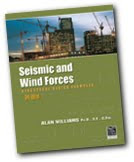
Performance-Based Plastic Design: Earthquake-Resistant Steel Structures
Publisher: International Code Council and co-branded by NCSEA
Pages: 280
The first practical design book for the structural engineer using the new Performance-Based Plastic Design (PBPD) method.
This innovative design guide discusses the Performance-Based Plastic Design (PBPD) method for earthquake resistant steel structures recently developed by author Subhash C. Goel and his associates. PBPD is a direct design method that produces final designs requiring no or minimal iteration as opposed to what is generally required in current practice. The PBPD method produces structures with targeted and predictable response in a direct manner.
The text is filled with formulas, tables, and drawings to assist the practicing engineer as well as graduate student in understanding this highly technical, yet innovative and effective, design method. Purchase this book.
For more products from the International Code Council, please visit our store.







